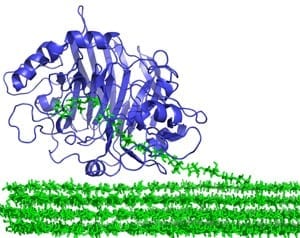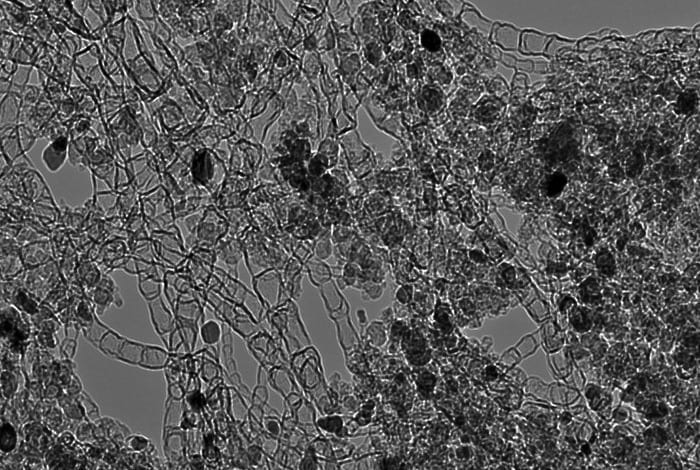
Scientists have discovered a new enzyme that could prove an important step in the quest to turn waste (such as paper, scrap wood and straw) into liquid fuel.
To do this they turned to the destructive power of tiny marine wood-borers called ‘gribble’, which have been known to destroy seaside piers.
- Robust enzyme discovery that could help lead to sustainable biofuels
- Enzyme to create liquid fuel from wood could be produced in the same way that enzymes for biological washing detergents are made
- First 3D image of aquatic animal enzyme provides previously undiscovered picture of how it works
Using advanced biochemical analysis and X-ray imaging techniques, researchers from the University of York, University of Portsmouth and the National Renewable Energy Laboratory in the USA have determined the structure and function of a key enzyme used by gribble to break down wood. The findings, published in PNAS, will help the researchers to reproduce the enzymes effects on an industrial scale in a bid to create sustainable liquid biofuels.
To create liquid fuel from woody biomass, such as wood and straw, the polysaccharides (sugar polymers) that make up the bulk of these materials have to be broken down into simple sugars. These are then fermented to produce liquid biofuels. This is a difficult process and making biofuels in this way is currently too expensive.
To find more effective and cheaper ways of converting wood to liquid fuel, scientists are studying organisms that can break down wood in hope of developing industrial processes to do the same.
Gribble are of interest as they are voracious consumers of wood and have all the enzymes needed for its digestion. The enzymes attach to a long chain of complex sugars and chop off small soluble molecules that can be easily digested or fermented. The researchers identified a cellulase (an enzyme that converts cellulose into glucose) from gribble that has some unusual properties and used the latest imaging technology to understand more about it.
The Latest Bing News on:
Waste into biofuel
- Cargill works to widen biofuel reach in shipping as Europe growth slowson April 30, 2024 at 11:49 am
Cargill began offering biofuels based on fatty acid methyl ester, also known as FAME and produced from biological waste streams, in 2021 for ships travelling between Singapore and Europe, in part with ...
- All jobs at biodiesel plant at risk as government urged to 'step in'on April 30, 2024 at 8:09 am
A union is calling for the Scottish Government to “step in now” to save jobs at risk at Scotland’s biggest biofuels company in North Lanarkshire. Unite the Union claim 75 workers at Argent Energy’s ...
- Reimagining energy: How former fossil fuel sites are driving the renewable revolutionon April 30, 2024 at 6:28 am
We examined the transformations of steel mills into wind turbine hubs, coal mines into solar sanctuaries, and more.
- Oil refiner Neste says CEO Matti Lehmus will be stepping downon April 29, 2024 at 12:33 pm
Finnish refiner Neste said on Monday its president and CEO Matti Lehmus would be stepping down and that the company was launching a hunt to find his replacement.
- Feds give financial boost to biofuel sector amid growing U.S. competitionon April 29, 2024 at 7:12 am
Canada’s biofuel industry is welcoming a proposed multi-billion dollar package of financial support from the federal government, although concerns remain about whether it will be enough to compete ...
- New $60m lab in S’pore to drive R&D in carbon capture, biofuels and hydrogenon April 26, 2024 at 8:20 pm
Transforming Singapore’s energy and chemical sectors will be a priority, says DPM Heng Swee Keat. Read more at straitstimes.com.
- Berlin residents upset with ‘overwhelming' smell from nearby food waste recycling facilityon April 26, 2024 at 3:24 pm
It’s almost like a rancid meat smell when it happens and the odor permeates,” Tasca Ford General Manager Tom Moran said. An unpleasant odor is creating unhappiness for residents and businesses like ...
- Biofuels Will Be A Key Part Of The Net-Zero Solutionon April 22, 2024 at 6:00 am
Fuel sourced from living matter could greatly reduce our greenhouse gas emissions. Companies are working on solutions that don't undermine biodiversity in the process.
- Could We Power Flights With Human Waste?on April 21, 2024 at 8:00 am
Aviation companies are exploring the use of human waste to produce sustainable aviation fuel (SAF), aiming to meet growing demands for low-carbon alternatives and government emissions targets.
- Trucking firm’s green project converts ramen soup into biofuelon April 17, 2024 at 5:00 pm
The head of the Nishida Shoun trucking company here poured his passion into fashioning ... the completed biodiesel can be combined with recycled fuel made from other kinds of waste oil.
The Latest Google Headlines on:
Waste into biofuel
[google_news title=”” keyword=”waste into biofuel” num_posts=”10″ blurb_length=”0″ show_thumb=”left”]
The Latest Bing News on:
Sustainable biofuels
- Biden administration details how producers of sustainable aviation fuel will get tax creditson April 30, 2024 at 3:29 pm
The Biden administration is out with new guidelines for tax credits for producers of sustainable aviation fuel ...
- SAF Tax Credit Guidelines More Stringent Than Biofuels Industry Hopedon April 30, 2024 at 3:06 pm
Producers of SAF are eligible for a tax credit of $1.25 to $1.75 per gallon. SAF that achieves a GHG emissions reduction of 50% is eligible for the $1.25 credit, while SAF that achieves a GHG ...
- Treasury releases Sustainable Aviation Fuel tax guidanceon April 30, 2024 at 2:21 pm
The Treasury Department and the Internal Revenue Service today released guidance on eligibility rules for biofuels to qualify for Sustainable Aviation Fuel tax credits.The news release contains ...
- Vilsack says agriculture is in the game when it comes to sustainable aviation fuelon April 30, 2024 at 1:50 pm
The U.S. Secretary of Agriculture says updates to a model that measures the carbon footprint for sustainable aviation fuel should allow U.S. agriculture to participate in the sustainable aviation fuel ...
- Sustainable Aviation Fuel Stakeholders Unite to Form the SAF Coalitionon April 30, 2024 at 7:19 am
The SAF Coalition is comprised of airlines and aircraft operators, agricultural enterprises, aircraft and aircraft equipment manufacturers, airports, technology developers, ...
- Straits Energy’s unit completes first delivery of ISCC EU-certified marine biofuelon April 30, 2024 at 1:45 am
Straits Energy Resources Bhd’s (Straits Energy) subsidiary, Tumpuan Megah Development Sdn Bhd, has completed the first delivery of ...
- Monjasa completes first biofuels supply operation in Peruon April 29, 2024 at 11:20 pm
Monjasa and FAMOIL have supplied a total of 510 tonnes of B30 marine biofuels, for the first time in South America, in the port of Callao, Peru, to the Cargill operated dry bulk carrier, Infinity Sky.
- Aviation industry rules that neither corn nor soybeans meets its 'sustainable' guidelineson April 28, 2024 at 3:01 am
Federal policymakers and Big Ag "encourage" changing benchmarks so that ethanol SAF can be meet "green" energy standards.
- Biofuels Supply Too Scarce for Shipping Sector, Says Hapag-Lloydon April 23, 2024 at 11:51 pm
There’s currently insufficient production capacity to make biofuels suitable for the shipping sector, making it a challenging option as a sustainable fuel, said Ilyas Muhammad, head of green fuels at ...
- Biofuels Will Be A Key Part Of The Net-Zero Solutionon April 22, 2024 at 6:00 am
Fuel sourced from living matter could greatly reduce our greenhouse gas emissions. Companies are working on solutions that don't undermine biodiversity in the process.
The Latest Google Headlines on:
Sustainable biofuels
[google_news title=”” keyword=”sustainable biofuels” num_posts=”10″ blurb_length=”0″ show_thumb=”left”]










